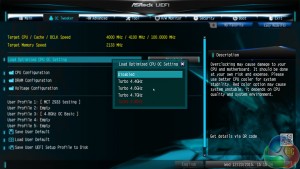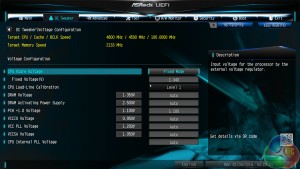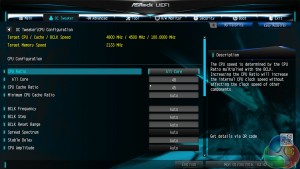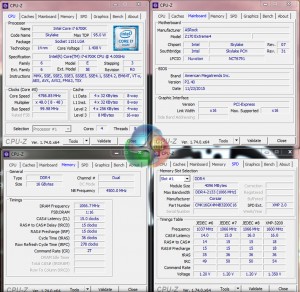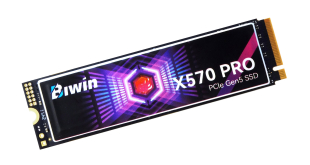Automatic CPU Overclocking:
ASRock’s four included CPU OC profiles are:
- 4.4GHz static, 4.2GHz cache, auto voltages and LLC, disabled power savings.
- 4.6GHz static, 4.2GHz cache, auto voltages and LLC, disabled power savings.
- 4.7GHz static, 4.0GHz cache, 1.36V Core Voltage and Level 1 LLC, disabled power savings.
- 4.8GHz static, 4.0GHz cache, 1.39V Core Voltage and Level 1 LLC, disabled power savings.
I think this is a decent set of overclocking profiles that should be achievable on a wide range of CPUs, even with mid-range cooling hardware.
The 4.8GHz overclocking preset was technically stable (with the exception of the high-speed memory support while overclocking, which made a 2933MHz DRAM frequency unstable), although the Z170 Extreme4 motherboard forced the CPU VCore as high as 1.472V.
This is an obscenely high voltage level which is potentially dangerous for the long-term life of a 14nm Skylake CPU. With 1.472V being registered via software, despite the 1.39V BIOS setting and Level 1 LLC, the level of overshoot being applied by ASRock's motherboard is very concerning. This issue is likely to be related to the current BIOS profile, rather than the power delivery hardware, meaning that it could potentially be fixed with future updates.
Manual CPU Overclocking:
As already mentioned, the P2.40 BIOS profile used for the Z170 Extreme4 applies a CPU VCore overshoot of around 70mV when overclocked. As such, we manually adjusted the desired voltage levels to account for the significant overshoot. We were also forced to reduce the DDR4 memory to 2133MHz as it was unstable at 2933MHz when the system was overclocked.
To test the ASRock Z170 Extreme4 motherboard’s CPU overclocking potential, we first increased the CPU VCore to 1.34V and also set the PCH voltage to 1.10V. We selected level 1 load-line calibration (LLC) and set the cache ratio to 45x.
Navigating ASRock's UEFI is simple, as is finding the appropriate overclocking settings.
Only once the DDR4 memory was reduced from 2933MHz was the 4.8GHz CPU overclock (with 4.5GHz CPU Cache) fully stable. ASRock clearly has memory stability issues with the board's current BIOS profile.
CPU VCore under Prime95 load sat around the 1.41V mark, which is an overshoot of 70mV compared to what we set in the UEFI. This is disappointing and needs addressing in future iterations of the board's BIOS.
 KitGuru KitGuru.net – Tech News | Hardware News | Hardware Reviews | IOS | Mobile | Gaming | Graphics Cards
KitGuru KitGuru.net – Tech News | Hardware News | Hardware Reviews | IOS | Mobile | Gaming | Graphics Cards


